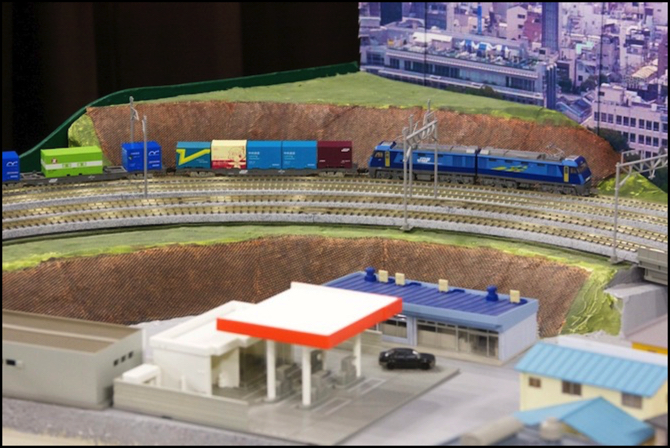Express Freight
31 May 2012 22:08 Filed in: Prototype

Those two words sound like an oxymoron: freight isn’t fast. What usually matters most is high capacity and predictable delivery, even trains carrying perishables aren’t in a great hurry. For most U.S. modelers, a “freight” is something that trundles along at 40 mph (64 kph) or less, and “express” probably conjures up images of the old Railway Express Agency, which handled parcel and small package transport via express cars on passenger trains and other methods, until highways made it unprofitable (REA had stopped using express cars on passenger trains well before it filed for bankruptcy in 1975). High-speed trains also cost more to operate, not simply in fuel, but in terms of constructing and maintaining track to the more exacting standards needed for higher speeds.
But in Japan, the narrow-gauge railway network already exists for passenger use at speeds of 110 kph (68 mph) or higher. And passenger trains run frequently enough that it is easier for faster freight trains to fit in with them. Still, most Japanese freight trains run at lower speeds, in part due to older equipment that isn’t suitable for higher speeds. Older trains were limited to 65 kph (40 mph), although this was raised to 75 kph (47 mph) for many in the 1960s, and some freight cars were rated for 85 kph (53 mph) operation.
Most freight in Japan today consists of unit trains running between ports, industries, and sometimes freight yards, mainly container yards or yards serving ports, as the Japan National Railway eliminated general freight and its classification yards in 1985, shortly before being broken up into the JR Group companies that include JR Freight.
Some of those container trains operate for express companies that want to move containers of smaller parcels long distances quickly, and Japan’s rail network lets JR Freight compete against air cargo, and least on short-to-medium length routes. Some express freights operate overnight over distances of 500 km (about 300 mi).
When containerized freight was introduced the equipment was originally limited to 85 kph (53 mph), making it an express by the standards of the day. In 1966 the KOKI 10000 container flat car was introduced, bringing the top speed to 100 kph (62 mph), and later this was raised to 110 kph (68 mph) for some models. Today container flats can run at 110 kph on track that supports this speed, and even petroleum tank trains can run at speeds up to 95 kph (59 mph).
The real hotshot is the M250 Super Rail Cargo train (which I described back in February), a container freight EMU capable of operating at up to 130 kph (81 mph), and making a nightly run of a bit more than 500 km (300+ miles) from Tōkyō to Ajikawaguchi Station in Osaka for Sagawa Express in 6 hours and 10 minutes, an average speed of 91 kph (57 mph).
High speed freight trains today are divided into three classes (Japanese wikipedia): class A, rated for 100 or 110 kph but also including the M250, class B rated for 95 kph which includes both container trains and tank trains using the TAKI 1000, and class C rated for 85 kph. There are two lower classes of ordinary “dedicated” freight train (Japanese wikipedia): class A (yes, they reuse the letters), rated for 75 kph and class B rated for 65 kph, although it sounds like the last one is fairly rare now.
But an even faster train is planned. Today, freight trains from the island of Hokkaido in the north operate south to Tōkyō and beyond, carrying farm products and other materials. To do this, they have to travel through the Seikan tunnel, a 54 km (34 mi) undersea tunnel linking the mainland and the island. In 2015, Shinkansen will start to use the tunnel, and 110 kph freights pose a problem (although apparently some will still operate using dual-gauge track in the tunnel). If I’m reading the translation right, the normally 260 kph tunnel would be limited to 140 kph if non-Shinkansen were sharing it.
A rather clever solution was reached: the narrow-gauge freight cars (apparently limited to KOKI 100-series container flats) will be rolled onto covered standard-gauge (I think) carrier cars and pulled by a new EH800 electric locomotive. This will allow freight to operate through the tunnel and over adjacent tracks at speeds up to 200 kph (124 mph).
That’s still not the fastest freight train in the world (planned, anyway). In Europe, Euro Carex is developing a high-speed freight service targeting speeds up to 300 kph (186 mph), and Siemens has a Velaro Cargo planned (c.f., Today’s Railways, Europe, issue 197, May 2012, pg 25), if they can find a buyer, capable of operating at up to 350 kph (217 mph). That’s express freight indeed.
But while Japan may not have the fastest freight trains in the world, or the most, they still operate a large number of freights at speeds that are quite swift indeed.



